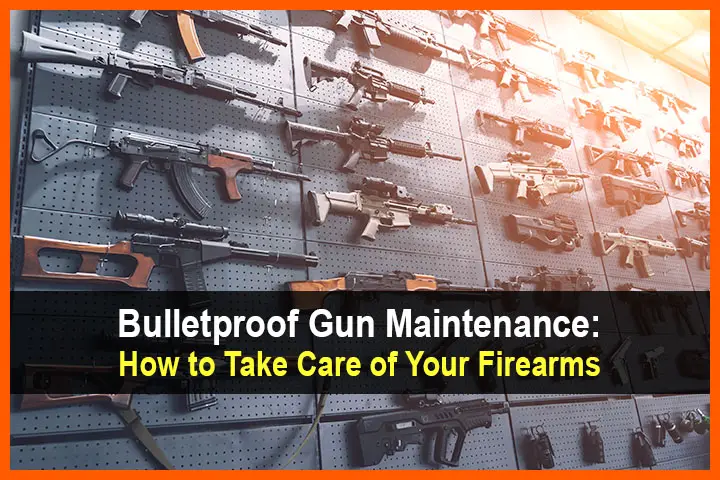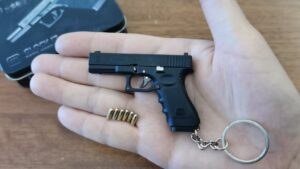Estimated reading time: 12 minutes
While many states have passed concealed carry laws for firearms allowing for everyday carry, most of us store our guns long-term waiting for that annual, fall hunting trip or for emergencies. Regardless of your usage, maintenance is a critical step in firearms ownership not only for safety reasons, but to maintain the quality and performance of the gun over the long-term.
We’ll cover a range of steps to take to maintain guns including storage, cleaning, lubricating, and troubleshooting malfunctions. The telegram is that you should clean your gun after every use and always store it unloaded and locked up.
Want to save this post for later? Click Here to Pin It On Pinterest!
Common Problems
A buildup of residue from copper and powder can create a range of problems with a gun. One of the primary reasons for gun cleaning is to remove copper and powder residue that occurs after firing. Without proper cleaning the operation of critical mechanisms will eventually fail resulting in a loss of accuracy and even misfires or worse.
Another residue buildup often occurs with ammunition that is not copper coated. But even then, a lead buildup can occur particularly in the barrel where the rifling can abrade both the copper coating and the lead core.
Various solvents are designed to remove any residue buildup and we’ll cover the recommended solvents with links if you want to order them online.
Lack of lubrication is another common problem. A gun is a complex combination of mechanics that require a certain degree of lubrication. Which parts require lubrication; how much and what type of lubricant is also important and we’ll cover gun cleaning for rifles, handguns and antique firearms a little later.
Wear and tear occurs with everything and the basic mechanics of a gun, combined with the powerful impacts that a gun receives can accelerate wear and tear. Take the time to inspect your gun every time you clean it and if you’re concerned about the wear or function of a part and are reluctant to make your own repairs, consider taking it to a gunsmith for an opinion.
BOOKS:
VIDEOS:
ARTICLES:
Gunsmithing
Gunsmithing can be simple or complex. Some elements of gunsmithing involve minor adjustments to trigger sensitivity and other adjustments you can make to improve the accuracy, reliability and safety of any firearm. Other elements involve replacement of parts, rifling and other complicated improvements.
Gunsmithing is not something that should be approached lightly and varies depending on the type and brand of gun. We’ll cover a range of books, videos and articles about gunsmithing that hopefully cover a good range of guns and how to take maintenance to a gunsmithing level.
BOOKS:
Storage – Best Practices
Most guns spend most of their time in storage. The ideal storage location is a gun safe or at least a small, locking case. This is not only a security measure but it will protect a gun from humidity fluctuations that can affect not only the metal components but the wood stocks and grips common on many guns.
The ideal humidity range for gun storage is 40 to 50% humidity although lower humidity won’t be a problem for any gun without wooden components, and even then a rifle or handgun with wooden stocks or grips will tolerate very low humidity if oiled and not left in storage for years.
Just as important as cleaning and lubrication and storage environment are various tools and equipment that are wise to consider for any gun storage:
Gun Lockers
Specialized gun lockers offer the best all-around solution to gun storage but there are other supplies that can preserve and protect guns in storage.
Gun Socks
Gun socks are long fabric sleeves that have been treated with silicone. They serve to protect metal and wooden parts from the affects of fluctuating humidity and/or temperature extremes. They won’t protect a gun against everything, but under proper storage conditions they can act as an extra step to effective storage. In a pinch they’re better than just propping up a rifle in the corner of a closet.
Trigger Locks
An added level of security for any firearm is a trigger lock. This will make the gun impossible to fire. The size and designs vary and you should look for a trigger lock that is compatible with the firearm.
Absorbers
Oxygen and moisture absorbers are common for long-term food storage and there are specialized absorbers for gun storage. They only last so long but if you think your storage for any firearm will be long-term it’s a good idea to try and manage the storage environment.
Ammunition Storage
Many people choose to store their ammunition separate from the area where any firearm is stored. This is largely to prevent children or others from finding, loading and firing a gun without your knowledge. Regardless of your situation, a dedicated case or locker for ammunition storage is a good idea. Ammunition also requires certain conditions for long-term storage as well.
BOOKS:
VIDEOS:
ARTICLES:
Travel Storage and Maintenance
Whether you’re traveling for a hunting trip or bugging out in the midst of a disaster, traveling with firearms requires some level of consideration. A lot has to do with where and why you’re traveling with a gun and how long you may be at your destination.
Gun Cases
There are dedicated rifle cases designed for transporting rifles while protecting them the elements. Some are combinations of fabric and leather with straps that simply keep the gun contained and easy to carry. Others are hard cases designed for shipment or travel by plane or ship.
They always have to be checked as luggage but there are some hard and fast rules about how weapons can be transported especially on airplanes. Anyone who has ever flown to a destination for a hunting trip or safari knows all too well how to pack and check-in with firearms when flying commercially.
Field Cleaning Kits
These are smaller kits designed for gun cleaning and lubrication without a major breakdown or disassembly of the weapon. Many hunters know that some hunting trips only require that a rifle be fired once during the length of the trip, but even then it’s wise to do a field cleaning of any gun after it’s fired.
Field Stripping vs Complete Disassembly
Field stripping basically involves cleaning the barrel, the receiver and checking the slide on handguns. Complete disassembly is the recommended way to clean a firearm and requires a workbench, gun vise, a range of tools, solvents and lubricants and patience.
Here are some links to videos and articles that cover the various ways to both field strip and completely disassemble a gun for cleaning and maintenance. More importantly, consult your owner’s manual for specific recommendations for how to both field strip and disassemble your gun. Many gun shops also offer classes on gun maintenance and they’re worth considering so you can ask questions as you go.
BOOKS:
VIDEOS:
ARTICLES:
Rifle Maintenance
The firing mechanisms of any gun have a lot of common elements. Then again, there are obvious differences between a rifle and a handgun and often different tools and solvents. Here again, your owner’s manual should offer some good advice on unique needs and steps.
And here’s some links to more books, videos and articles that cover some of the things you need to do when cleaning and maintaining a rifle across a variety of rifle types:
BOOKS:
VIDEOS:
ARTICLES:
Handgun Maintenance
Handguns also vary from semi-automatics like Glocks and Berettas to revolvers. Attention to details related to the mechanism of different types of handguns is obviously important and should be covered in your owner’s manual.
Here are various links to books, videos and articles about the steps and method for cleaning and maintaining various handguns.
BOOKS:
VIDEOS:
ARTICLES:
Vintage and Antique Gun Maintenance
Some people collect guns, others find themselves in possession of firearms previously owned by a grandparent or great grandparent. Many of these firearms fall in the category of antiques or at least vintage guns.
Most of them are very fundamental particularly the older antiques. Others have unique mechanisms and maintenance needs. Almost all of them have wooden stocks or grips.
A critical decision is whether or not you simply want to display the antique or actually fire it. Maintaining an antique firearm for display is largely cosmetic, but it would be wise to have it properly cleaned for firing in case someone decides to give it a try.
Take your time to really understand all aspects of care and maintenance with an antique firearm before firing it. In fact, if you’re not sure you may be well served to have a gunsmith check it out so you know it’s safe to fire.
The gunsmith can also give you the best advice on the proper caliber and ammunition to use if a gun seems to be a mysterious or unknown caliber. Don’t assume. Make sure you load an antique gun (or any gun) with the proper ammunition.
Many vintage and antique guns require some level of gunsmithing to repair or replace parts. Do your homework and if in doubt, have any home gunsmithing that you do double checked by your local gunsmith.
The tools and solvents are essentially the same for cleaning and maintenance but if you encounter something you’ve never seen before, here are some links to various videos, books and articles about maintaining antique and vintage guns.
BOOKS:
VIDEOS:
ARTICLES:
Troubleshooting
If a rifle or handgun seems to be malfunctioning it can be from a variety of reasons. Everything breaks eventually even regular maintenance. The best solution for most of us is to take the gun to a gunsmith. They can not only repair it safely but offer some advice on how to prevent any malfunctions in the future.
If you want to try and do your own repairs, here are some excellent books on various types of guns that can guide you. If you have any doubts, find a gunsmith.
BOOKS:
VIDEOS:
ARTICLES:
Notes on Lubricants and Solvents
Various solvents and lubricants have been especially developed for cleaning and maintaining guns. It’s very wise to make sure you use the right solvents and lubricants and understanding how to apply them, and in the case of lubricants – how much to leave behind on any mechanism or part.
Here are some of the best solvents and lubricants for gun maintenance. If your owner’s manual recommends a certain brand or type it’s probably very wise to use it.
Solvents:
Lubricants:
VIDEOS:
Take the Time to Maintain Your Firearms
The accuracy and safety of any gun is significantly affected by how well it is maintained. Once you get in the habit of regularly cleaning and occasionally disassembling and inspecting, the easier it will be to keep your guns in their best condition.
Like this post? Don’t Forget to Pin It On Pinterest!

















